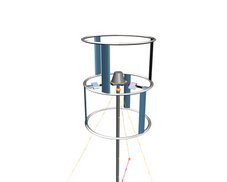Optimized Urban-Scale Wind Power
Wind-Sail has developed a patented vertical-axis wind turbine that delivers breakthrough performance, cost, and operational benefits specifically optimized for urban-scale clean power. Based in the Bay Area, California-based Wind-Sail is now seeking venture capital to certify initial 3 kW platform and launch global sales and contract manufacturing.
Wind-Sail Overview
Wind power today is a $27 Billion market worldwide, growing at 40% yr/yr[1], with ever larger turbine systems deployed as utility-scale wind farms. To maximize the power these turbines can produce, these farms are typically placed in the highest wind regions in the world. Yet, most people don’t live in Class 5 wind regions, and furthermore, most people in urban environments would not want or could not feasible deploy these massive systems – with spinning blades that approach the speed of sound and are bigger than Boeing 777 airplanes.
Wind-Sail was founded on a belief that significant wind power opportunities exist in for urban-scale small and mid-range power applications (1-3 kW, 30-50 kW systems). However, to be successful in urban environments, new approaches, new formats, and key new features were required to make wind turbines practical for city applications.
Based on scientific and engineering research funded by Lawrence Berkeley Labs, Wind-Sail has innovated a vertical axis wind turbine (VAWT) with best-in-class aerodynamic efficiency and performance features for commercial and urban-scale power applications. Our competitive advantages are driven by these key urban benefits of the VAWT:
§ Optimized Efficiency: Highest CPP (40%) of any distributed wind power system. System is omni-directional, capturing the gusty, variable winds that are typical in urban and light/medium wind regimes.
§ Smaller Footprint: Compact design ideal for constrained environments in industrial, urban, campus, and hybrid solar applications.
§ Innovation Through Simplicity: System is easier to manufacture (fewer parts).
§ Scalability: Will scale from 1 to 50 to 500 kW formats.
§ Operational savings: more reliable with one bearing set, more durable with slower spinning blades, and less maintenance than any turbine on the market today.
§ Multiple configuration options: Turbines can be stacked, installed sideways, upside, or at any angular dimension for applications where space constraints or wind conditions necessitate new formats. In addition, because there are no significant blade clearance issues below the turbine, system can be installed in certain applications without costly towering installations or foundations.
Wind-Sail’s turbine technology has been computer simulated, water and air tunnel tested, prototyped, fine-tuned, patented, and now scaled to successful working models in 1, 3 and 30 kW formats. One of the working units has a small video demonstration at: www.wind-sail.com
Wind-Sail Team
Wind-Sail's executive team has over 40 years of experience in the engineering, production, sales and executive management in electric motor and power component industries.
• Rich McClellan, PhD, CEO
Veteran executive of 3 electronics startups sold to Parker-Hannifin, Motorola, Printronix. Doctorate and is industry expert in power electronics.
• Rick Halstead, CTO
Power industry innovator with extensive management, sales, and technical development expertise with alternators engineered for harsh environs.
• Vladimir Krivopickj, PhD, Technical Leader
Leads core blade/turbine design team. Aerodynamic engineer with
30 years of experience in
• Chris Larson, Project Leader
25 year veteran of PG&E with project management experience across plant, grid, substation and environmental projects in the Bay Area. Leads the site management and permit applications for our Treasure Island install project.
• Jeremy Stieglitz, Marketing & BD
15 year high technology veteran with experience launching and growing product lines of $2M-$800M for Microsoft, RSA, and Cisco Systems.
Competitive Position
There are several companies selling small scale wind turbines based on traditional, horizontal axis propeller based turbines, including Bergey and Southwest Wind. There are also a growing number of VAWT turbines, primarily selling in
Patents protect key innovations in the aerodynamics of the blades, vertical orientation of the system, the system wind loading and blade configurations, aerodynamic ring structure, the alternator, and the electronic control optimizations for distributed wind.
Markets
The global market today for distributed wind power is today a $400M market, and is forecasted to grow 10x over the next 10 years to $4BN. According to the American Wind Energy Association (AWEA), “to date about 110 MW of “small-scale” community wind capacity is installed in the
Needs from Investors:
Wind-Sail has had no external investment and corporate structure remains flexible. We are seeking $1.5m-$2m in seed/angel funding to establish key first customer deployments in strategic and tactical sales opportunities. An additional investment of $5-$7M will be sought to grow the launch team, scale contract production, establish global distribution and sales offices, and expand sales and marketing programs worldwide.
Summary Contact Information:
(650) 575-2317





|